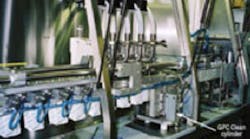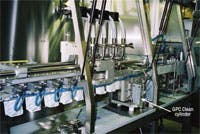Pouches are becoming an increasingly popular method of packaging liquids. They are lighter than cans, more portable than bottles, and once empty, they lay flat, so they take up less space in trash receptacles and landfills.
The next level of environmental awareness is to make the pouches out of environmentally friendly materials. That’s just what Swedish company Ecolean has done. Ecolean, located in Helsingborg, Sweden, developed Ecolean Calymer, a special packaging material consisting of approximately 40% calcium carbonate (natural chalk) and polymers as the binding agent. As with cans or bottles, Ecolean’s pouches are free-standing, stable, and easy to handle, making them ideal for automated, high-speed packaging. But unlike cans and bottles, the pouches do not require complex machine handling and sealing.
Application-specific solutions
Ecolean offers its customers application-specific production lines with filling and packaging stations for liquid products. To this end, Ecolean designs machines that are fast, reliable, and low-maintenance, and can be operated by only one worker.
Whether a large or small operation, each customer receives pre-finished, printed packaging on reels that correspond to their specifications. The packaging is delivered as hygienic, hermetically pre-sealed reels and loaded into the machine. After being unrolled, each individual package is then slit open at the top edge. In Ecolean’s LeanAir packaging, which has two chambers — one of which serves as a stabilizing handle — the liquid product is first filled into one chamber, then air is pumped into the handle. Ecolean’s single chamber LeanBase packaging is simply filled with the liquid product. The finished package is ready for shipment after it has been heat sealed. The entire process takes only 2.4 sec. The extremely short filling time and hygienic packaging ensure the same quality as that of the product inside. The reels are then placed in a ready-for-operation machine.
Resistant to the elements
“The majority of our customers are dairy operations, which, of course, have their own special environmental requirements,” explains Christian Olsson, technical product manager at Ecolean. “Therefore, we need components that can withstand factors such as cold, humidity, and splashes from liquid products. This mainly applies to the pneumatic cylinders used. Previous cylinders caused problems from the many holes in their housing that can quickly be affected by splashes.”
Even though dairy products and fruit juices may seem wholesome, they (or the cleaning solutions to remove them) can corrode metal surfaces — an unacceptable condition in these types of machines. Furthermore, Olsson explains that linear guides of cylinders they had been using were too weak, which created problems with reliability. Sebastian Ekelund, a development engineer at Ecolean, reports, “When selecting the machine components, technology was a main focus, but, above all, supplier competence was the most important factor.”
A special solution
Engineers at Ecolean wanted an air cylinder with primarily flat surfaces so food products would be less likely to accumulate and be easier to clean off if they did. They also wanted a cylinder with heavy-duty linear guides to stand up to the physical challenges of the application. However, they found nothing on the market to address these requirements.
They turned to one of their established suppliers, Bosch Rexroth, who developed the GPC Clean pneumatic guide cylinder. Anders Wallstrm, industry sector manager, food & packaging for Bosch Rexroth, says the specifications for the GPC Clean correspond to those of a conventional cylinder with integral linear guides: working pressure from 1 to 8 bar, bores from 10 to 63 mm, ball or friction bearings, and magnetic pistons. However, he explains that the GPC guide cylinder uses linear guide bearings that are larger than mandated by industry standards, so it tolerates higher off-center loading, while maintaining high repeatability in positioning.
Olsson continues, “The pneumatics experts at Bosch Rexroth assisted us with fine-tuning once we constructed the first machine. Close cooperation during this phase showed us that they understood the problem. The cylinders we use today were not available from Bosch Rexroth during our machine development phase.”
Bosch Rexroth provides cylinders for the majority of the Ecolean machines, along with a plate that can be directly mounted to hold four tools. Olsson offers, “This saves us assembly time, as we receive both components as a plug-and-play unit.”
Clean & quiet with long life
The GPC Clean has an anodized aluminum housing and guide bushings that can withstand even the most intensive cleaning. However, the clean design reduces the frequency of required cleaning. Wallstrm explains that the GPC Clean’s surface is completely smooth and has no obstructive grooves or holes, making it ideal for applications in food processing applications involving product splashes.
Ecolean uses the GPC Clean series cylinders in its Ecolean EL1 and EL2 machines that work with container sizes between 200 ml and 1 l, with a standard deviation of 3 ml. Ecolean requires a fast guide cylinder, particularly in its sealing unit. Design engineer Rasmus Johansson explains the reason for this: “The last millimeters of the stroke are especially important, as perfect package sealing is only possible with absolutely exact controlling. This is ensured by the high precision of the GPC Clean.”
Strategic cushioning
Ecolean is also the leader of the pack in another respect: not only is great importance placed on the environmentally-friendly characteristics of the packaging, but noise generation of the machines is kept low. Sebastian notes, “The pneumatic cylinders have air cushioning and run very quietly. All of this has a positive effect at the workstation.” Additionally, this air cushioning prevents vibrations in the machine, making the components less susceptible to wear, resulting in longer service life for the cylinders.
In contrast to the desired convenience of cushioning, Ecolean wanted cylinders with factory-set cushioning that could not be adjusted by the user. Johannsson explains, “We wanted to do away with any potential sources of user error to make the machines easy for anyone to operate. To accomplish this, we rely on a fixed cylinder that is adjusted once at the factory and then remains unchanged, ensuring smooth operation.”
The packaging machines can be set up very easily, since the complexity is actually in the packaging itself. Christian Olsson sums up that it is also a question of cost efficiency: “Customers can repair our machines or exchange parts themselves. This makes the packaging concept appealing for small as well as for large operation.”
Wallstrm says Ecolean initially specified the GPC clean for use in the machines’ welding (heat sealing) station. Following this successful application, it is now also used as a clamp to hold the pouch in place as it is slit open and in a lift table during filling.
For more information on Bosch Rexroth, visit www.boschrexroth-us.com



